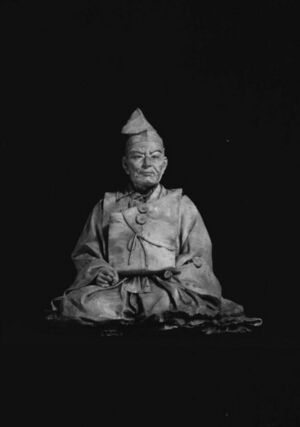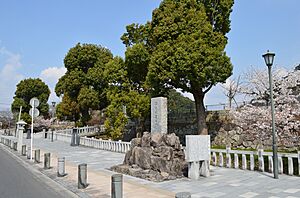Shimazu Yoshihisa facts for kids
Quick facts for kids
Shimazu Yoshihisa
|
|
|---|---|
| 島津 義久 | |

Statue of Yoshihisa
|
|
| Head of Shimazu clan | |
| In office 1566–1587 |
|
| Preceded by | Shimazu Takahisa |
| Succeeded by | Shimazu Yoshihiro |
| Personal details | |
| Born | February 9, 1533 Izaku Castle |
| Died | March 5, 1611 Kokubu Castle, Kagoshima |
| Parents |
|
| Relatives | Shimazu Yoshihiro (brother) Shimazu Toshihisa (brother) Shimazu Iehisa (half-brother) |
| Military service | |
| Allegiance | |
| Rank | Daimyo |
| Unit | |
| Commands | Kagoshima |
| Battles/wars |
|
Shimazu Yoshihisa (島津義久, February 9, 1533 – March 5, 1611) was a powerful Japanese leader, known as a daimyō, who lived from 1533 to 1611. He was the 16th head of the Shimazu clan in Satsuma Province. Yoshihisa was the oldest son of Shimazu Takahisa.
He was famous as a great general. He managed to bring the entire Kyushu island under his family's control. He did this with the clever help of his three brothers. By 1585, Yoshihisa had taken control of almost all of the Kyushu region.
Contents
Becoming a Leader
Shimazu Yoshihisa was born in Izaku Castle around 1535. His childhood name was Torajumaru. Later, he changed his name several times, finally settling on Yoshihisa.
In 1566, he took over from his father. This made him the sixteenth leader of the powerful Shimazu clan.
Uniting Kyushu Island
Yoshihisa worked closely with his brothers: Shimazu Yoshihiro, Shimazu Toshihisa, and Shimazu Iehisa. Together, they started a big plan to unite all of Kyūshū island.
Their journey began in 1572. They won an important battle against the Itō clan at battle of Kizaki. They also won the Siege of Takabaru in 1576. Yoshihisa kept winning battles across the island.
In 1578, Yoshihisa defeated the Ōtomo clan at the battle of Mimigawa. His forces chased the Ōtomo army back to their home lands.
Later, in 1581, Yoshihisa's army captured Minamata Castle in Higo Province. They used a large force of 115,000 soldiers.
In early 1584, his forces won the Battle of Okitanawate in Hizen Province. They defeated the Ryūzōji clan and the Aso clan.
By 1585, Yoshihisa's forces attacked Horikiri Castle. They also captured Otomo's Iwaya Castle after invading Chikuzen Province.
By the middle of 1585, the Shimazu clan controlled many provinces. These included Chikugo, Chikuzen, Hizen, Higo, Hyūga, Osumi, and Satsuma. This meant they controlled most of Kyūshū. Only the Ōtomo clan's area remained outside their control.
Facing Hideyoshi
In 1585, as the Shimazu clan tried to unite Kyushu, other clans asked for help. The Otomo clan and Ryuzoji clan reached out to Toyotomi Hideyoshi. Hideyoshi was a powerful leader in Japan.
Hideyoshi asked Yoshihisa to make peace with the Otomo clan. But Yoshihisa did not think Hideyoshi was strong enough to invade Kyushu. So, he ignored Hideyoshi's request.
In 1586, Shimazu Yoshihisa marched to attack Otomo's Tachibanayama Castle. Tachibana Muneshige and his wife defended the castle bravely.
The Otomo leaders then traveled to Osaka to ask Hideyoshi for help again. Hideyoshi was impressed and agreed to help them. Yoshihisa realized Hideyoshi was serious about invading. He sent a message saying he had only attacked other clans to defend himself. But Hideyoshi refused and led his armies to Kyushu.
The Kyushu Campaign
In late 1586, Toyotomi Hideyoshi began his Kyushu Campaign. The Ōtomo forces got help from armies from Shikoku. These armies included those led by Chōsokabe Motochika. They slowed down the Shimazu forces. This weakened them before Hideyoshi's main armies arrived.
Hideyoshi gathered a huge army of 200,000 soldiers. He also had 20,000 pack animals to carry supplies. His first group, led by Toyotomi Hidenaga, had 25,000 men.
By April 1587, Hideyoshi reached the straits at Shimonoseki. He moved through Chikuzen and Chikugo. His goal was to attack Yoshihisa in Higo. Forces from the Mōri clan also joined Hideyoshi's side.
Hideyoshi's army pushed back the Shimazu forces in Hyūga and Bungo. The Shimazu fought well, but they had fewer firearms. They also lacked the same training as Hideyoshi's large army. They were slowly defeated by Hideyoshi's superior numbers and skill.
By the end of May 1587, many local leaders on the island had joined Hideyoshi. In June, the Shimazu were defeated in Satsuma itself. Hideyoshi then began a Siege of Kagoshima castle. Yoshihisa asked for peace, and a truce was agreed upon. Hideyoshi offered fair terms for peace. Yoshihisa first refused, but Hideyoshi tried again and succeeded.
After Surrender
After his surrender, Yoshihisa lost most of the lands he had conquered. Hideyoshi gave these lands to his own generals. The Shimazu clan was only allowed to keep Satsuma Province and Ōsumi Province. They also kept half of Hyuga.
Yoshihisa shaved his head as a sign of surrender. This showed he would become a Buddhist monk if his life was spared. His name as a monk was Ryūhaku. It is not fully clear if he truly retired. His younger brother, Yoshihiro, controlled the troops under Hideyoshi. However, many believe Yoshihisa still managed the daily affairs of their lands.
Yoshihisa did not have a son to take over from him. So, he adopted his nephew, Shimazu Tadatsune. Tadatsune was the son of Yoshihiro. Tadatsune married Yoshihisa's third daughter, Shimazu Kameju.
Yoshihisa was also interested in culture. After Hideyoshi granted Hosokawa Fujitaka a retirement home in Osumi Province in 1595, Fujitaka taught Yoshihisa about classic literature. It is also thought that Konoe Wakihisa, a skilled poet, often visited Yoshihisa's home.
After his lands were divided by Hideyoshi, Tokugawa Ieyasu invited Yoshihisa to Fushimi Castle. Ieyasu and his helpers repeatedly asked Yoshihisa how he managed to unite Kyushu. Yoshihisa finally explained that he won his victories because of his loyal helpers. He said his three younger brothers, led by Yoshihiro, and other helpers like Uwai Satokane and Yamada Arinobu, fought very well together. He said he just had to wait in his castle for news of their victories. After Yoshihisa left, Ieyasu told his own helpers that Yoshihisa was a great general. He let his helpers work to the best of their abilities.
His Final Years
Shimazu Yoshihisa passed away on March 5, 1611. He died from an illness at Kokubu Castle.
He was buried at what used to be the site of Fukushoji in Kagoshima. His tombstone is still there, along with those of other Shimazu clan leaders. There are also monuments built to remember him in other places.
There is no known portrait of Yoshihisa today. However, there is a bronze statue of him at the Taiheiji temple. This statue shows him surrendering to Hideyoshi. It was made after he died.
Important Helpers
Yoshihisa had many important people who helped him.
From the Shimazu Clan
- Shimazu Yoshihiro
- Shimazu Toshihisa
- Shimazu Iehisa
- Shimazu Tadanaga
Other Key People
- Niiro Tadamoto
- Yamada Arinobu
- Uwai Satokane
- Ei Hisatora
- Ijūin Tadamune
- Hongo Tokihisa
- Hongo Tadatora



